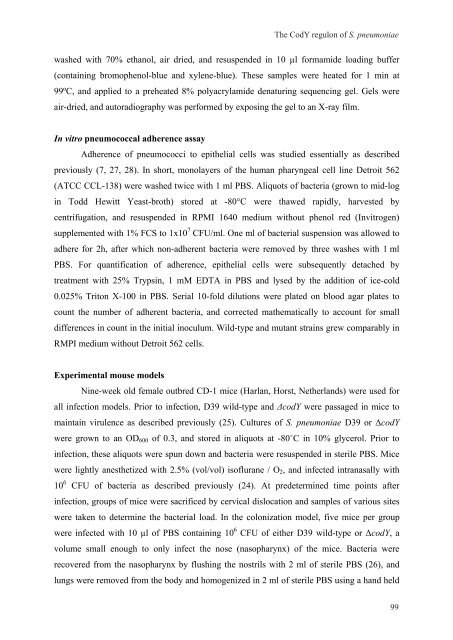Gene regulation in Streptococcus pneumoniae - RePub - Erasmus ...
Gene regulation in Streptococcus pneumoniae - RePub - Erasmus ...
Gene regulation in Streptococcus pneumoniae - RePub - Erasmus ...
Create successful ePaper yourself
Turn your PDF publications into a flip-book with our unique Google optimized e-Paper software.
The CodY regulon of S. <strong>pneumoniae</strong><br />
washed with 70% ethanol, air dried, and resuspended <strong>in</strong> 10 µl formamide load<strong>in</strong>g buffer<br />
(conta<strong>in</strong><strong>in</strong>g bromophenol-blue and xylene-blue). These samples were heated for 1 m<strong>in</strong> at<br />
99ºC, and applied to a preheated 8% polyacrylamide denatur<strong>in</strong>g sequenc<strong>in</strong>g gel. Gels were<br />
air-dried, and autoradiography was performed by expos<strong>in</strong>g the gel to an X-ray film.<br />
In vitro pneumococcal adherence assay<br />
Adherence of pneumococci to epithelial cells was studied essentially as described<br />
previously (7, 27, 28). In short, monolayers of the human pharyngeal cell l<strong>in</strong>e Detroit 562<br />
(ATCC CCL-138) were washed twice with 1 ml PBS. Aliquots of bacteria (grown to mid-log<br />
<strong>in</strong> Todd Hewitt Yeast-broth) stored at -80°C were thawed rapidly, harvested by<br />
centrifugation, and resuspended <strong>in</strong> RPMI 1640 medium without phenol red (Invitrogen)<br />
supplemented with 1% FCS to 1x10 7 CFU/ml. One ml of bacterial suspension was allowed to<br />
adhere for 2h, after which non-adherent bacteria were removed by three washes with 1 ml<br />
PBS. For quantification of adherence, epithelial cells were subsequently detached by<br />
treatment with 25% Tryps<strong>in</strong>, 1 mM EDTA <strong>in</strong> PBS and lysed by the addition of ice-cold<br />
0.025% Triton X-100 <strong>in</strong> PBS. Serial 10-fold dilutions were plated on blood agar plates to<br />
count the number of adherent bacteria, and corrected mathematically to account for small<br />
differences <strong>in</strong> count <strong>in</strong> the <strong>in</strong>itial <strong>in</strong>oculum. Wild-type and mutant stra<strong>in</strong>s grew comparably <strong>in</strong><br />
RMPI medium without Detroit 562 cells.<br />
Experimental mouse models<br />
N<strong>in</strong>e-week old female outbred CD-1 mice (Harlan, Horst, Netherlands) were used for<br />
all <strong>in</strong>fection models. Prior to <strong>in</strong>fection, D39 wild-type and ΔcodY were passaged <strong>in</strong> mice to<br />
ma<strong>in</strong>ta<strong>in</strong> virulence as described previously (25). Cultures of S. <strong>pneumoniae</strong> D39 or ΔcodY<br />
were grown to an OD600 of 0.3, and stored <strong>in</strong> aliquots at -80�C <strong>in</strong> 10% glycerol. Prior to<br />
<strong>in</strong>fection, these aliquots were spun down and bacteria were resuspended <strong>in</strong> sterile PBS. Mice<br />
were lightly anesthetized with 2.5% (vol/vol) isoflurane / O2, and <strong>in</strong>fected <strong>in</strong>tranasally with<br />
10 6 CFU of bacteria as described previously (24). At predeterm<strong>in</strong>ed time po<strong>in</strong>ts after<br />
<strong>in</strong>fection, groups of mice were sacrificed by cervical dislocation and samples of various sites<br />
were taken to determ<strong>in</strong>e the bacterial load. In the colonization model, five mice per group<br />
were <strong>in</strong>fected with 10 µl of PBS conta<strong>in</strong><strong>in</strong>g 10 6 CFU of either D39 wild-type or ΔcodY, a<br />
volume small enough to only <strong>in</strong>fect the nose (nasopharynx) of the mice. Bacteria were<br />
recovered from the nasopharynx by flush<strong>in</strong>g the nostrils with 2 ml of sterile PBS (26), and<br />
lungs were removed from the body and homogenized <strong>in</strong> 2 ml of sterile PBS us<strong>in</strong>g a hand held<br />
99<br />
99

















